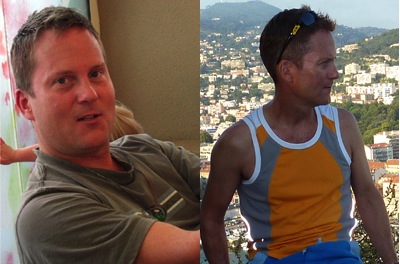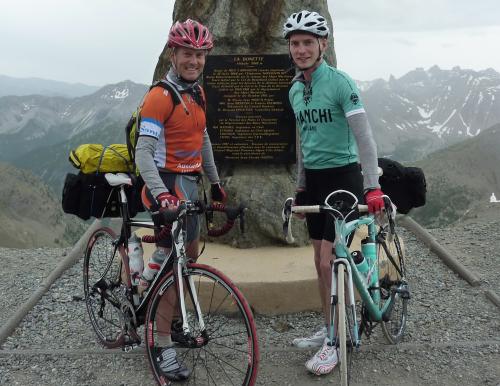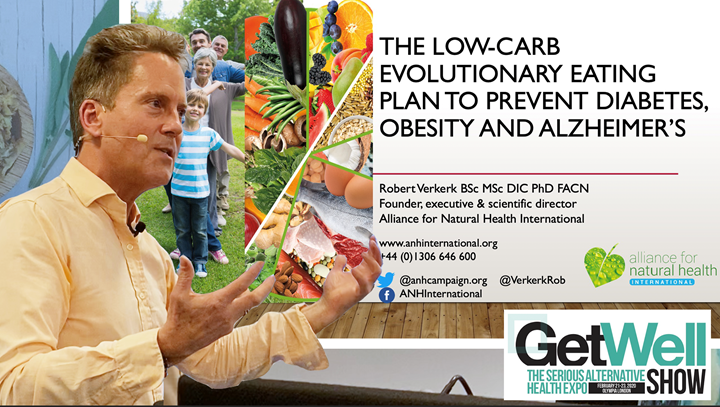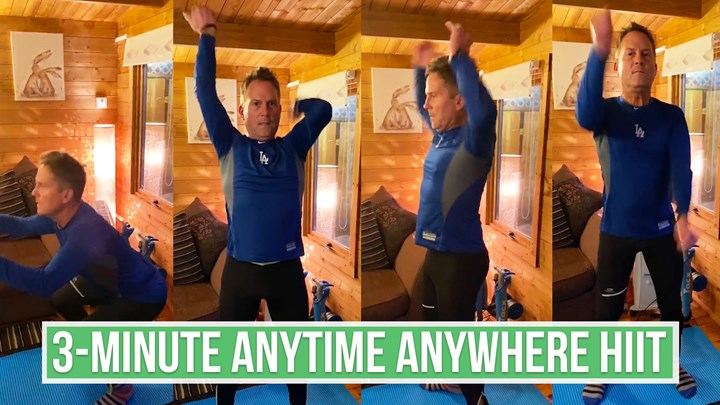Content Sections
By Robert Verkerk PhD
Executive and scientific director, ANH-Intl
Going downhill slowly
Like to so many of us, I was succumbing to 20th century lifestyle diseases as I approached my first half-century. Physical inactivity, born of intense, long hours behind a desk, was, I believe, the single biggest culprit contributing to my increasing waistline, rising blood pressure and persistent feeling of fatigue after lengthy work days. In fact, it was this post-work fatigue that conspired to prevent me from becoming more active in my limited spare time. Added to this was my desire to maximise time with my family. In my case, having been responsible for two batches of kids, I should add that 34 years of my life will be spent being responsible for children under the age of 18!
Good diet simply not enough
It seemed that what would be typically described as a good diet and positive mindset were not enough to compensate for my relatively low level of activity, which typically amounted to a 1- or 2-hour mountain bike ride every couple of weeks. Many of us will experience a wake-up call at some time. Ideally, this will occur well before any Western medic would diagnose clear symptoms of heart disease, diabetes or — since the two so often run hand-in-hand — cardiometabolic syndrome. Over a period of 10 years, I had gained around 20 kg in weight, had developed a lipid profile that could not be described as entirely healthy, had mild hypertension (elevated blood pressure) and seemed to be permanently exhausted. When I laid my head on the pillow at night, my pulse would be pounding so hard in my head that the thought of getting up early and going on a run or a bike ride before work seemed like the best way of bringing on a heart attack. At the time, of course, it would have been a dangerous thing to do, and our survival instinct can often provide a reasonable assessment of whether we’re ready for more intense exercise.

Rob (aged 49) in August 2009 (left), before becoming more physically active, and in June 2012 (right) in Nice after cycling the Alps
Following in Hannibal’s footsteps (sort of….)
For any of you who have followed our Facebook and Twitter feeds over the last week, you’ll know that I successfully cycled across the French Alps — from Grenoble to Nice — together with my eldest son, Misha. Okay, our route was closer to Napoleon’s than it was to Hannibal’s, but during the course of our ride, we included some of the toughest climbs used during the 100-year-plus history of the Tour de France. This involved Alpe d’Huez (1,860 m), Col de Galibier (2,645 m) and one of the highest paved roads in Europe, Col de la Bonette (2,802 m). In four days, Misha and I covered a vertical ascent that exceeded the height of Mount Everest — on laden bikes and with backpacks.

Father and son on Col de la Bonette (2,802 m)
Nipping metabolic syndrome in the bud
Just 45 minutes after our arrival at the Mediterranean coast at Nice last Wednesday afternoon, Misha received the anticipated email from administrators at University College Hospital, London, letting him know the results of his final medical exams. As it happened, the results couldn’t have been better: Misha qualified as a medical doctor with distinction! With a celebratory drink of the bubbly stuff in our sweaty palms, I listened very closely to the newly qualified, 24-year-old medical doctor across the table from me. He commented both on the extent of my recent physical changes and the relative ease with which I was able to ride those mountains on a laden bike. He also confirmed that, while I no doubt would have had pre-clinical symptoms of metabolic disease back then, few conventional doctors would have done much about them. And since medical students are not trained in diet and lifestyle modification, action — typically largely pharmacological in nature — would generally only be taken when health had deteriorated further and conditions had become considerably more serious. And there lies the time bomb that concerns so many of us.
Going uphill fast
So what were the triggers for my decision to seriously incorporate more physical activity into my lifestyle? When you’re pedalling up mountains, you have time to mull over such things. I decided there were three key factors:
- Full-body photograph. In the spring of 2010, my wife took a picture of my youngest daughters and I emerging from a lake during an early English heat wave. When I initially glanced at the adult in the photo, I thought it was someone else! I simply hadn’t been prepared to accept that I needed to act upon the slow extension of my girth, even though I knew fewer and fewer of my clothes were fitting. Denial of weight gain is a common problem, and looking at yourself in a mirror briefly every day might not be sufficient to trigger a sharp change in diet or lifestyle. Have a partner or friend photograph you in your swimsuit and see if you’re happy with your physique. A body composition scale that measures weight, % body fat, % muscle and visceral fat can also be a very useful indicator. But remember, you don’t necessarily want to just fit with the average statistics for someone of your age and gender — you might decide you want to lean on the better than average side if you can, because many average individuals are already on the road toward metabolic disease!
- Oral health. I had managed to use the excuse of my hectic work schedule as a reason for not seeing a dentist for around 3 years. Yet I was suffering persistent toothache in my lower jaw. I took the step of going to a dentist who specialised in ‘biocompatible dentistry’. This dentist not only dealt with a low-level infection that had developed under an old crown I had had fitted nearly 30 years ago, he also found a mercury filling dating back to my early childhood that I thought had already been removed. As many now know, both oral infections and mercury contribute to stress that can lead to chronic disease, such as heart disease.
- Adjusted food and dietary regime. Many of us simply accepted the much-publicised notion of eating small meals and snacks regularly as a principle means of stabilising blood sugar. Few of us had heard about the emerging opinions suggesting that this eating strategy will push many of us into insulin resistance and propagate low-grade inflammation, triggered via our immune response each time we expose ourselves to food. Eager to test the new-found wisdom, I dropped any type of snacking and maintained at least 5-hour fasts between meals, drinking only water in between. I also increased my protein intake and largely eliminated grains – especially wheat – from my diet, using vegetables, and to a lesser extent fruit, as my principle carbohydrate sources. And because water can also set off an immune response, I now wait until I’m thirsty and then bulk water drink, rather than drinking — as some advocate — little and often. On top of this, I found supplements that gave me energy like no others had done previously. These were wholly naturally derived, being based on fruits, vegetables, herbs and spices cultured in a probiotic culture medium modelled on a healthy human intestinal tract. The products deliver a diverse range of end-chain B vitamins, antioxidants (notably lipoic acid) and the reduced form of coenzyme Q10, ubiquinol. Quite simply, with the help of these products, I now felt I had the energy to get back on a bicycle.
Coupled with these changes, I used a very specific training regime that didn’t require massive hours in a gym or in the saddle, something I find is difficult to incorporate into my busy lifestyle. But we’ll discuss training techniques that help in endurance activities in a future article.
If this article helps a few more people to become more physically active again, it will have served a purpose!
Call to action
- Ensure you have balance in your life! Pay attention to your diet and nutrition, your level and type of physical activity, and the quality and nature of your rest and relaxation. Also ensure that you are satisfying your higher needs, which give you purpose in life.
- Only consider active, intense exercise if you are sure you are ready for it. Seek advice from a competent and experienced nutritional and lifestyle practitioner if you have any doubts. Take steps that are likely to help you to feel more comfortable expending plenty of energy, such as sleeping more, eating better, cutting out alcohol or transforming stress in your life.
- Don’t wait to take stock of your diet and lifestyle only once you have clear symptoms of chronic disease. Staying healthy for as long as we can is something that is most strongly within our individual control. You need to build time and space into your life to be able to do this. Each one of us has the potential to be most fulfilled if we personally take ultimate responsibility for our own health.








Comments
your voice counts
28 June 2012 at 1:01 pm
. Seek advice from a competent and experienced nutritional and lifestyle practitioner if you have any doubts.
Not many of those have the slightest clue. Its all the cholesterol and calories BS, and..exercise-wise, its the obsolete 220 minus age for heart rate, that going out 30 years ago, then, on to the Borg Perceived Exertion Formula, then that going out a year ago, passing the baton to the Peak8s.
21 August 2012 at 11:44 pm
Enjoyable and interesting article - thanks. Personally I could recommend the bodyweight training methods of Mark Lauren who designed the fitness program for US special forces. He claims 30 mins intensive work 4 days a week and good nutrition is all thats necessary. He has a website, book and a very useful iphone/android app. Check out www.marklauren.com
BTW Robert could you make clear what those supplements products you used were?
23 August 2012 at 6:25 pm
Hi, thanks for getting in touch and for the tip - we'll check Mark Lauren out! As for your question, we can't give out the name of specific supplements via the website, but if you'd like to get in touch by email at [email protected], we'll be happy to give you some further information.
Your voice counts
We welcome your comments and are very interested in your point of view, but we ask that you keep them relevant to the article, that they be civil and without commercial links. All comments are moderated prior to being published. We reserve the right to edit or not publish comments that we consider abusive or offensive.
There is extra content here from a third party provider. You will be unable to see this content unless you agree to allow Content Cookies. Cookie Preferences